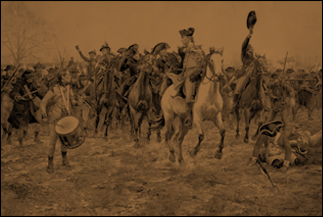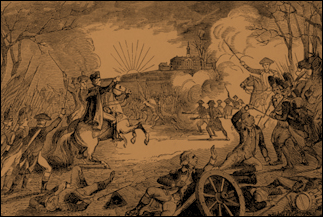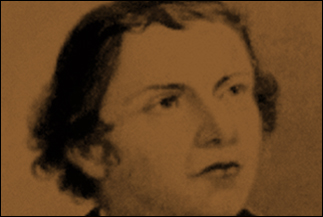 Battle of Princeton #1
Battle of Princeton #1
 Battle of Princeton #2
Battle of Princeton #2
 Battle of Princeton #3
Battle of Princeton #3
 General Hugh Mercer
General Hugh Mercer
Background
The night after the Second Battle of Trenton, General Washington stealthily led the roughly 6,000-man main body of his army away from Lieutenant General Lord Cornwallis and his troops. To disguise the departure of the American soldiers, Washington left a detachment of 500 Pennsylvania militia behind to tend to large campfires and periodically fire volleys from two cannons. During the night, Washington's army marched over a back road toward Princeton and reached the Quaker Bridge over Stony Brook, about a mile and a half south of the town. The Quaker Bridge was not strong enough to support the army's cannon and ammunition carts, so another bridge had to be hastily built. While it was being constructed, Washington divided his army into two groups: a large right wing under General John Sullivan, and a smaller left wing with 2,300 men under General Nathanael Greene. Washington had intended to attack Princeton before dawn, but the sun was rising.
Greene's assignment was to advance to the Princeton-Trenton highway to block traffic there and destroy the highway bridge over Stony Brook. Sullivan's division, the main attack force, moved toward the rear of the College of New Jersey (now Princeton University). The British were known to have outposts on the roads leading north, east, and west, so Sullivan took an abandoned road that went into town from the east.
Before Greene's wing could reach the highway, its leading brigade, made up of 350 men under General Hugh Mercer of Virginia, met up with 800 men of the British 4th Brigade, armed with 2 light guns, under the overall command of Lieutenant Colonel Charles Mawhood. The British group had been marching from Princeton to Trenton to reinforce General Leslie's 2nd Brigade. The remaining unit of the 4th Brigade had been left to hold Princeton along with another 400 men.
The Battle
The initial contact at Princeton was between General Hugh Mercer's advance corp moving toward the Stoney Brook along Quaker Bridge road, against British Col. Mawhood, who was leading most of the 55th regiment and other additional troops toward Trenton. As Mawhood crossed the Stoney Brook, both sides spotted the other. Both sides moved to a nearby hill above the Princeton Road (now 206). Mawhood opened fire as the Americans came over the ridge, and followed with a bayonet charge. Mercer's men, armed mostly with rifles, were driven off.
The advancing Militia were also repelled by Mawhood's regiment-Mawhood was outnumbered 3 or 4 to one, but he and his men stood steadfast. Washington himself lead up more Continentals, got the militia to return to the fight, and after a few volleys Mawhood had to retreat across the Stoney Brook.
Upon sighting the American force, Mawhood formed up his men in a defensive position across the edge of an orchard, which Mercer's troops were passing through. A violent firefight ensued, and Mawhood launched an assault which largely cleared the orchard of Mercer's troops, who began to retreat in confusion. General Mercer was wounded but refused to surrender. When he tried to attack the enemy with his sword, he was bayoneted and presumed dead; he died of his wounds nine days later. Colonel John Haslet of Delaware replaced General Mercer and was killed by a shot to the head.
Washington Rallies Mercer's Men
During the confusion, General Washington rode up to rally Mercer's men, while a fresh brigade of 2,100 troops under General John Cadwalader arrived with an artillery battery. Washington then rode straight into the British fire, personally leading the attack. As Washington charged towards the British lines, he was heard yelling
"Parade with me my brave fellows, we will have them soon!"
Legend has it that Washington was obscured by smoke, but when it cleared, he was still there. With Cadwalader's reinforcements and Washington's successful rallying of Mercer's men, the larger American force was able to attack the British flanks and retake most of the orchard, until fire from Mawhood's guns halted the American advance.
The Battle is Won
A second British assault cleared the orchard, and seemed about to win the day until Sullivan led up another 1,300 troops. Now outnumbered nearly 6 to 1, Mawhood led a final charge to break through the American lines. A number of British soldiers broke through the Americans in a desperate bayonet charge, continuing down the road to Trenton. Washington led some of his force in pursuit of Mawhood, then abandoned the pursuit and turned around when some of Leslie's 2nd Brigade troops were sighted.
The remainder of the British force fell back to Princeton, where, along with the troops already present, they defended the town against Sullivan's force before retreating to New Brunswick. After driving in a detachment of the 55th regiment, Sullivan marched into Princeton. Most of the remaining British forces retreated toward New Brunswick, but some took up a defensive position in the stone university building, Nassau Hall.
The Americans set up cannons facing Nassau Hall of Princeton University, and two cannonballs made contact with the walls of the hall. The British soldiers at Princeton were soon forced to surrender to the Americans, and Nassau Hall was recaptured. Cornwallis immediately moved to bring his army to engage Washington. This attempt failed due to a delaying force which damaged the Stoney Point Bridge and delayed the British. A number of British troops left behind in Princeton, facing overwhelming numbers and artillery fire, surrendered. The British casualty list stated 86 killed and wounded, and 200 captured. The Americans suffered 40 killed and wounded.
These two victories, and the resulting resurgence of the militias from NJ, Pennsylvania, Delaware, New York and Connecticut, forced the British out of most of New Jersey, boosting the morale of the Americans. The British were soon forced into an enclave around New Brunswick, giving up the rest of New Jersey."
In Trenton
Cornwallis and his men awoke to the sounds of cannon fire coming from behind their position. Cornwallis and his army began to race towards Princeton. However, Washington's rear guard had managed to damage the bridge over the Stony Brook, and American snipers further delayed Cornwallis' advance. The exhausted American Army slipped away, marching to Somerset County Courthouse (now Millstone), where they spent the night. When the main British force finally reached Princeton late in the day, they did not stay but quickly continued on toward New Brunswick.
Aftermath
The attempt of the British to show the Americans they could not fight the British army had failed. The British now realized it would be a long war.
After the battle, Cornwallis abandoned many of his posts in New Jersey, and ordered his army to retreat to New Brunswick. The battle at Princeton cost the British some 276 men killed, wounded or captured and greatly boosted the morale of the Continental troops, leading 8,000 new recruits to join the Continental Army.
American historians often consider the Battle of Princeton a great victory, on par with the battle of Trenton, due to the subsequent loss of control of most of New Jersey by the Crown forces, as well as the important political implications of the battle across the Atlantic in France and Spain, both of which would expand their military aid to the Continental forces after the battle. Fredrick the Great is said to have pronounced Washington's achievements in those few weeks "the most brilliant in military history".
The site of the battlefield is south of Princeton and has become the Princeton Battlefield State Park. The mortally wounded General Mercer reportedly rested under an oak tree on the battlefield. The surrounding Mercer County is now named after him; the Mercer Oak is pictured on its seal. The tree died in 2000 and a replacement grown from its acorns was planted on the site.
The 3rd Battalion/112th Field Artillery Regiment claims lineage from the Eastern Artillery Company of New Jersey assigned to Thomas Procter's 4th Continental Artillery Regiment, which took part in battle of Princeton.
Princeton Battlefield State Park
The State of New Jersey preserves 100 acres of the site as the Princeton Battlefield State Park. The park is located on Mercer Road (Princeton Pike), about 1.5 miles south of Princeton University and 3.8 miles north of Interstate 295/95.
PREVIOUS: The 2nd Battle of Trenton | Battle of Princeton | Home




